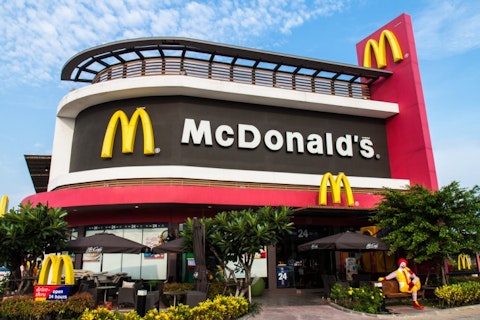Dividend aristocrats are by definition some of the most wide-moat and dependable stocks available on the market today. Dividend aristocrats are stocks that have had their dividend payments increased for at least the last 25 years, passing the tests of the 2002 and 2008 recessions with flying colors. Each one also has strong pricing power and considerable hedge fund support.
In this article, we’ll take a look at some of the smart money’s favorite dividend aristocrats, which are Johnson & Johnson (NYSE:JNJ), Lowe’s Companies, Inc. (NYSE:LOW), Walgreens Boots Alliance Inc (NASDAQ:WBA), McDonald’s Corporation (NYSE:MCD), and Exxon Mobil Corporation (NYSE:XOM).
While there are many metrics that investors can assess in the investment process, the hedge fund sentiment is something that is often overlooked. However, hedge funds and other institutional investors allocate significant resources while making their bets and their long-term focus makes them the perfect investors to emulate. This is supported by our research, which determined that following the small-cap stocks that hedge funds are collectively bullish on can help a smaller investor to beat the S&P 500 by around 95 basis points per month (see the details here).

saknakorn / Shutterstock.com
#5 Exxon Mobil Corporation (NYSE:XOM)
– Number of Hedge Fund Shareholders (as of June 30): 60
– Total Value of Hedge Funds’ Holdings (as of June 30): $3.02 billion
– Hedge Funds’ Holdings as Percent of Float (as of June 30): 0.80%
Given that it’s the largest public energy company in the world (until Saudi Aramco eventually IPO’s in 2017), Exxon Mobil has unrivaled economies of scale that allow it to earn solid returns on its invested capital. Due to great leadership, Exxon Mobil also has one of the energy sector’s best balance sheets and credit ratings. All of those qualities have helped Exxon Mobil increase its dividend for 33 straight years, even in 2015 and 2016, when crude prices fell hard. Currently, the integrated major pays a quarterly dividend of $0.75 per share, which amounts to a juicy annual yield of 3.5%. 60 out of the 749 funds that Insider Monkey tracks which filed 13Fs for the June 30 reporting period were long Exxon Mobil Corporation (NYSE:XOM), unchanged from the March reporting period.
Follow Exxon Mobil Corp (NYSE:XOM)
Follow Exxon Mobil Corp (NYSE:XOM)
Receive real-time insider trading and news alerts
#4 McDonald’s Corporation (NYSE:MCD)
– Number of Hedge Fund Shareholders (as of June 30): 63
– Total Value of Hedge Funds’ Holdings (as of June 30): $3.03 billion
– Hedge Funds’ Holdings as Percent of Float (as of June 30): 2.90%
Although the number of funds that had holdings in the restaurant chain fell by 20 during the second quarter to 63 at the end of June, McDonald’s Corporation (NYSE:MCD) was still the fourth-most popular dividend aristocrat among the smart money in our database. Being one of the most famous brands in the world, McDonald’s has been able to successfully franchise its restaurants to tens of thousands of locations around the world and generate very profitable and stable cash flows in the process. The stable income has allowed McDonald’s to raise its dividend for 39 straight years to its current $0.89 per share quarterly mark. Like Exxon, McDonald’s annual yield is currently north of 3%.
Follow Mcdonalds Corp (NYSE:MCD)
Follow Mcdonalds Corp (NYSE:MCD)
Receive real-time insider trading and news alerts
Hedge funds’ three favorite dividend aristocrats are analyzed on the next page.
#3 Lowe’s Companies, Inc. (NYSE:LOW)
– Number of Hedge Fund Shareholders (as of June 30): 67
– Total Value of Hedge Funds’ Holdings (as of June 30): $3.3 billion
– Hedge Funds’ Holdings as Percent of Float (as of June 30): 4.70%
Although its annual dividend yield of around 1.94% may not be as attractive as the yields of other names on our list, Lowe’s Companies, Inc. (NYSE:LOW)’s dividend is definitely one of the safest, as the company’s payout ratio is only in the 34.8% range. Lowe’s also has one of the longest histories of raising its dividend, having upped its payout for 53 straight years. The smart money is also growing more optimistic about the stock. According to our records, 67 funds that we track had a long position in Lowe’s Companies, Inc. (NYSE:LOW) at the end of June, up by three funds quarter-over-quarter.
Follow Lowes Companies Inc (NYSE:LOW)
Follow Lowes Companies Inc (NYSE:LOW)
Receive real-time insider trading and news alerts
#2 Walgreens Boots Alliance Inc (NASDAQ:WBA)
– Number of Hedge Fund Shareholders (as of June 30): 67
– Total Value of Hedge Funds’ Holdings (as of June 30): $4.43 billion
– Hedge Funds’ Holdings as Percent of Float (as of June 30): 4.90%
Walgreens Boots Alliance Inc (NASDAQ:WBA)’s dividend is about as dependable as it can get in the healthcare sector. The company has raised its dividend for 40 straight years to its current annualized payout of $1.50 per share, good for a 1.82% yield. Given that the pharmacy chain is only paying one-third of its profits in the form of dividends, Walgreens Boots Alliance’s management has been free to use the excess money to make long-term accretive acquisitions such as buying Rite Aid Corporation (NYSE:RAD), in a deal that is expected to close by the end of the year. Giving the aging population, robust drug price inflation (though this is coming under government scrutiny), and increasing health coverage in the United States, 67 funds in our system were long the stock as of June 30. Among them was Eric W. Mandelblatt‘s Soroban Capital Partners, which raised its stake in it by 183% in the second quarter, to over 5.24 million shares at the end of June.
Follow Walgreens Boots Alliance Inc. (NASDAQ:WBA)
Follow Walgreens Boots Alliance Inc. (NASDAQ:WBA)
Receive real-time insider trading and news alerts
#1 Johnson & Johnson (NYSE:JNJ)
– Number of Hedge Fund Shareholders (as of June 30): 82
– Total Value of Hedge Funds’ Holdings (as of June 30): $5.59 billion
– Hedge Funds’ Holdings as Percent of Float (as of June 30): 1.70%
With 82 hedge funds that we track owning shares of Johnson & Johnson (NYSE:JNJ) at the end of June, the stock ranks as the smart money’s top pick among dividend aristocrats. Not only has Johnson & Johnson increased its payout for 53 straight years, the company’s payments also amount to a solid annual yield of almost 2.69%. As has been the case for several decades now, analysts believe the right move is to either buy more of, or hold onto, Johnson & Johnson’s stock. Of the 22 analysts covering the stock, ten have ‘Buy’ ratings, 11 have ‘Hold’ ratings, and only one has a ‘Sell’ rating.
Follow Johnson & Johnson (NYSE:JNJ)
Follow Johnson & Johnson (NYSE:JNJ)
Receive real-time insider trading and news alerts
Disclosure: None





